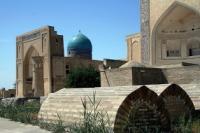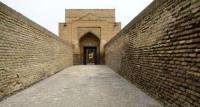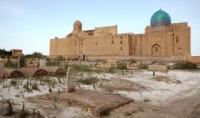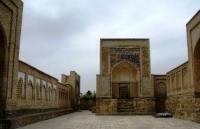You are here
Chоr-Bakr necropolis.




Tours over architectural places of interest of Bukhara province.
“If an ancient man saw planes two thousand years ago
He would've thought they were birds
Or angels from another world
Or messengers from other planets”
Dejan Stojanovic.
Cultural walks in Bukhara.
The Chor-Bakr memorial arose 8 km west of Bukhara in the village of Sumitan near the ancient necropolis of Dzhuibar seyyids. They occupied the highest state posts in Bukhara since the times of the Samanids. The memorial mosque, khanaka and madrasah, built at the end of the 16th century under Abdulla Khan II, occupy the central part of the memorial.
Their central facades are highlighted by portals with spacious arches, and the side walls are decorated with two tiers of loggias. The halls of the mosque and khanaki are covered with domes on slender drums. The interiors of the buildings are decorated with intersecting arches and cobwebs of net sails and stalactites.
In the XXth century, a small minaret was erected on the main axis of the complex. Particular attention of Abdullah Khan II to Chor-Bakr was connected with the fact that he and his father Iskander Khan considered themselves spiritual disciples of Khoja Muhammad Islam (died in 1563).
This sheikh in the middle of the XVI century was the head of the family of Dzhuibarsky Seyyids and the leader of the Sufi brotherhood of “nakshbandiya” of Central Asia. The successor of the sheikh was his son Khoja Abu Bakr Sa'ad (died in 1589), who, like his father, under Abdulla Khan II, was the head of the Muslims of Bukhara.
Chor-Bakr is like a "city of the dead", with streets, courtyards, gates, family dakhmas. The monumental memorial was erected in deep respect for the memory of Abu Bakr Sayad. Khoja Saad as the head of the “Nakshbandiya” was one of the largest feudal lords of the Khanate.
He owned land and other property in Bukhara, Miankala, Samarkand, Sauran, Turkestan, Ahsikent, Nesef, Hisar, Termez, Kubajians, Balkh, Badakhshan, Herat, Merv, Murgab, Mehne, Mashkhad, Chardju and Andhud.
The annual income of Khoja Sayad was equal to the annual income of the Samarkand region. Abdullah Khan II immortalized the memory of Khoja Sayad with the construction of a mausoleum, a mosque and a madrasa. According to the historical work "Abdullah-name", "when Abdullah Khan ascended the throne, he decided to leave behind a good name.
Khan planned to build a whole ensemble - a mosque, a madrasa, a residential house and other buildings around the Imam Abu Bakr Sayad mausoleum. Months and years passed, and finally, 10 years later, the gaze of his contemporaries was represented by a magnificent monumental structure surrounded by trees and flower gardens. ”
Authority:
V.G Saakov «History of Bukhara». Publishing house "Shark", 1996. «Bukhara. Masterpieces of the Central Asia». The historical guidebook across Bukhara. 2012. "Bukhoro. Bukhara" In the Uzbek, English and Russian languages. Publishing house "Uzbekistan", Tashkent 2000. Mukhammad Narkshakhi. History of Bukhara. Tashkent. 1897 (translator N.Lykoshina). V.G.Saakov "Architectural masterpieces of Bukhara. A Bukhara regional society "Kitabhon" Uzbek SSR, Exactly 1991 Robert Almeev. "History of ancient Bukhara". (Under edition of the Academician of the Academy of sciences of Republic Uzbekistan of Rtveladze E.V.)







